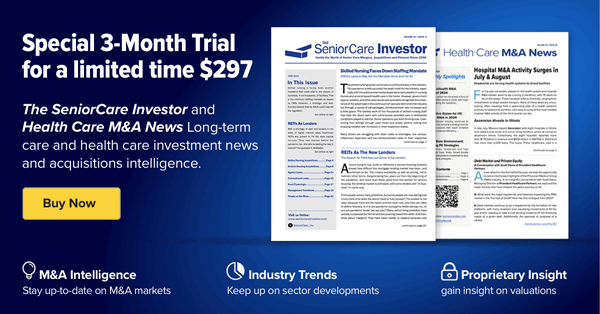The Diagnostics Market:
Despite a bustling M&A market in 2022, the diagnostics sector appears to have experienced a slowdown in deal activity, though it still remains relatively strong compared with previous years. As of May 15, 2023, a total of 26 deals have been announced year-to-date. Although this represents a 42% decline compared to the 45 deals observed during the same period in 2022, it still signifies a substantial 44% and 86% increase from the deal count in 2021 and 2020, respectively. These figures highlight the enduring interest in the diagnostics market, which increased out of necessity during the COVID-19 pandemic and continues to drive investment and strategic transactions.
Quest Diagnostics Inc (NYSE: DGX) and RadNet, Inc. (NASDAQ: RDNT) are two major publicly traded companies in the diagnostics industry, both of which have reported mixed Q1 2023 results, though that is to be expected when the market is undergoing so many swift changes and uncertainties in such a short period of time.
Quest Diagnostics Inc:
Quest Diagnostics enjoyed a period of success during the COVID-19 era with its roll-out of COVID-19 testing across the nation. However, the company has posted negative results in yet another quarter. After experiencing a 14.98% drop in revenue during Q4:22 compared to Q4:21, the company announced on April 27th a drop of 10.72% year over year.
According to Jim Davis, CEO of Quest Diagnostics, this significant decline is the result of significantly lower COVID-19 testing demand, resulting in an updated guidance for 2023.
Despite this drop in revenue, Quest Diagnostics exceeded analysts’ expectations by achieving an earnings per share of $2.04 for the first quarter, surpassing analysts’ estimates by $0.07. However, it’s important to note that this number is significantly lower than the earnings per share for the same period last year, which was $3.22, representing a decrease of about 36%.
The company also reported positive earnings in its base business, delivering double digit year-over-year revenue growth, “driven by strong performance across our physician and hospital customers,” said Mr. Davis, during the Q1 2023 earnings call.
Quest Diagnostics has not been a stranger in the M&A market. According to data captured in the LevinPro HC database, Quest Diagnostics announced three acquisitions each year during 2020, 2021 and 2022. During Q1 2023, Quest announced its acquisition of select assets of New York-Presbyterian’s laboratory services business for an undisclosed price.
Quest Diagnostics is keeping it’s M&A strategy alive with its latest announced acquisition of Haystack Oncology, an early-stage oncology company, for $300 million in cash at closing, net of cash acquired, and up to an additional $150 million on achieving future performance milestones. Now, with two acquisitions already announced this year, Quest Diagnostics is on track to surpass its M&A activity in recent years.
Mr. Davis spoke on this deal as well, saying that the acquisition of Haystack Oncology, “supports our molecular genomics and oncology strategy in the fast growing category of minimal residual disease testing.”
Despite the negative impact of declining testing demand, Mr. Davis remains optimistic, noting that “our updated guidance reflects continued strong performance in our base business, offset by faster than expected declines in COVID-19 revenues and modest dilution from our planned acquisition of Haystack.”
When we turn to the Q&A portion of the call, analysts seem to echo the optimism of the Quest executives, with some asking about the notable base volume growth and the factors driving it. One specific area of interest was the company’s success in gaining more market share with health plans and reference labs.
In his response to analysts, Mr. Davis emphasized the varied nature of this expansion, extending across all channels, including the physician segment and the health systems segment. Furthermore, Mr. Davis shed light on the vital role played by the professional lab services (PLS) division. He highlighted the growth in existing site same-store sales while also accentuating the strategic addition of new PLS sites. These include prominent locations such as Lee Health in Florida, Tower Health and Northern Light in Maine, exemplifying Quest’s ability to seize emerging opportunities.
Mr. Davis said, “Our growth in the quarter, [with a] 10% base revenue growth, was strong across all channels, our physician segment and our health systems segment… and PLS certainly helped the average growth rate in the quarter.” Despite the challenges posed by declining COVID-19 testing demand and negative revenues for another quarter, Quest Diagnostics has proven its resilience and adaptability, maintaining its well-earned position as a leader in the diagnostics market.
RadNet, Inc.:
The Los Angeles-based company saw its revenue grow 14.3% to $390.6 million in the first quarter of 2023 from $341.8 million in the first quarter of 2022. Excluding revenue from its AI reporting segment, RadNet’s imaging center segment generated revenue of $388.4 million, a 13.9% increase from the previous year.
With the imaging center volumes doing so well, RadNet announced that it is expecting as much as $235 million in earnings this year—up from previous projections of $230 million.
“We’ve increased our guidance ranges for revenue and adjusted EBITDA to reflect the first quarter’s strong financial results as compared with our original budget,” President and CEO Howard Berger, MD, said during the company’s May 9th Q1 2023 earnings call. “Though we remain vigilant about the economic environment, supply chain disruptions, inflation, and the possibility of further variants of COVID-19, we have opportunities to expand our operations in all of our markets, both organically and through new acquisitions and joint ventures.”
Although the company hasn’t announced any deals this year yet, RadNet has a history of strategic acquisitions, with 40 deals announced since 2007, as recorded in the LevinPro HC database. In 2022 alone, the company successfully executed three transactions. Looking ahead to 2023, we anticipate the redeployment of RadNet’s M&A strategy to further drive growth and market presence as it explores opportunities in the market.
However, RadNet faced challenges amid its otherwise positive performance. RadNet’s AI business line and other factors resulted in a net loss of $21 million for Q1 2023 compared to $3 million profit in the previous year. Despite this, projections for the AI business line remain unchanged, with RadNet anticipating losses of up to $11 million in 2023 before turning a profit in 2024.
According to RadNet, the company has also faced several “one-time items” in 2023 that hampered financial returns. These included $4.1 million in non-cash loss from interest rate swaps, $7.6 million in net pre tax expenses related to its artificial intelligence division, as well as leases for new centers under construction.
Mr. Berger added that both overall and same-center procedure volumes increased in Q1 2023, with PET/CT seeing the most significant gains at 20.9% year-over-year. Other modalities such as MRI, CT, X-ray, ultrasound and mammography also saw increases, although the cost and availability of labor remain a concern.
Responding to that, Howard G. Berger, CEO of RadNet, added, “Though the cost and availability of labor continues to be challenging, we are having more success in filling open positions and retaining talented team members.”
“With respect to volumes, we are experiencing heavy demand in virtually all of our markets,” said Berger.
RadNet is responding to the growing demand by constructing new centers and exploring additional joint-venture partnerships with hospital groups. The company is also keeping an eye on imaging centers for sale in a shifting economy, as market pressures could accelerate acquisition opportunities in a fragmented industry mostly made up of smaller operators who lack the economies of scale achieved by RadNet.


